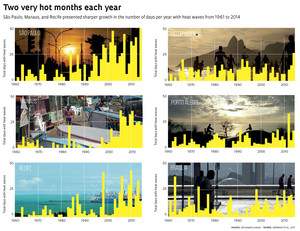
LÉO RAMOS CHAVES
Ibirapuera Park, São Paulo, November 2017: visitors cool off to feel more comfortableLÉO RAMOS CHAVESAt 3 p.m. on September 11, 2017, a Monday in late winter, the temperature in the capital of São Paulo reached 31.9 degrees Celsius (ºC), the hottest day of the season which should be the coldest of the year. During the winter of the previous year, thermometers reached 33ºC, so now inhabitants of the country’s largest city were once again faced with the discomfort caused by the strong sun, intense heat, and dry air, with relative humidity dropping to 28%. On this same September day, the city of Jales registered the hottest and driest day in the state of São Paulo during the winter, with 37.2ºC and humidity of 13%.
This phenomenon is known as a heat wave, at least three consecutive days with minimum or maximum temperatures higher than expected in a given region and period of the year. Although the phenomenon has already been reported in decades past, “Indian summers” have become increasingly frequent, intense, and long-lasting. In a study comparing six Brazilian state capitals between 1961 and 2014, Brasília had the longest heat waves, lasting 20.5 days each year, nearly three times as long as those in the city of Rio de Janeiro. Manaus leads in number of days with heat waves, 39 per year on average, even though the heat waves are not as long as in other cities, according to the study published in September in the International Journal of Climatology. In São Paulo, the periods of extreme heat surpassed the 15 days per year recorded during the 1960s and 1970s to reach 40 in 2010 and 50 days in 2014 (see graphs).
Heat waves are also linked to natural climatic cycles, although there are other potential causes; the humidity and frequent rains in the region of Manaus, for example, vary according to the oscillation of a range of storm clouds known as the Intertropical Convergence Zone. “The increase in the duration, intensity, and frequency of this climatic phenomenon reflects the higher global average temperature resulting from greater greenhouse gas emissions, and is partly exacerbated by heat islands [urban areas that trap heat and make the temperature higher than in surrounding areas],” says meteorologist Renata Libonati, professor in the Department of Meteorology at the Geosciences Institute of the Federal University of Rio de Janeiro (UFRJ) and coauthor of the study. She states that the construction of buildings and paving of streets make urban surfaces absorb more solar radiation than soil and vegetation. The lack of green areas, in turn, stops cities from releasing excess heat through evaporation and transpiration of trees.
“It is very likely that global climate change caused by human action and the increased heat waves are linked,” says Libonati. For years, climatologists have warned that climate changes manifest not only through continuous increase in temperature, but through occasional extreme events like heat waves and more intense and prolonged droughts, such as the current dry spell in the Brazilian northeast, which began in 2010 (see Pesquisa FAPESP, issue No. 249).
This scorching weather is not limited to Brazil. The World Meteorological Organization (WMO) blamed a heat wave for the record temperature of 54ºC registered on July 21, 2016 in Mitrabah, Kuwait, and 53.9ºC in Basra, Iraq, on the following day. At the same time, a widespread heat wave hit the United States, with temperatures between 35ºC and 38ºC; at the height of summer in the Northern Hemisphere, on July 22, the American National Weather Service estimated that 124 million people were affected by the heat wave.
This climatic phenomenon is expected to intensify around the world this century, according to the Intergovernmental Panel on Climate Change (IPCC), increasing discomfort and mortality risk, especially for children and the elderly. Heat waves caused around 70,000 deaths in Europe in 2003, 10,000 in Russia in 2010, and at least 2,300 in India in 2015. “This topic has been widely discussed in the Northern Hemisphere, but this is not yet the case in Brazil, despite the serious effects of heat waves on health, especially for more vulnerable populations,” said Libonati.
 Mortality increases
Mortality increases
Because of the excessive heat in recent years, total mortality in China caused by heat waves lasting five days increased by 18%, and rose by 24% in the elderly and 22% in women. “Children and the elderly are most susceptible to thermal variation because of their low capacity to maintain body temperature,” explains epidemiologist Nelson Gouveia, professor at the University of São Paulo School of Medicine (FM-USP). He adds that people with lower educational levels and widowers also seem to face slightly higher risk than the average population during these events, which may be explained by the fact that they are less likely to seek medical help when needed.
“Heat waves hasten the deaths of vulnerable people,” summarizes economist Paulo Henrique Cirino Araújo, a professor at the Federal University of Goiás. In his doctoral research, which he completed in 2017 at the Federal University of Viçosa, he observed that during a heat wave, the total number of deaths in children up to 5 years old who were hospitalized with infections or parasitic diseases (especially dengue) increased from 24% to 30% in the states of Mato Grosso, São Paulo, Goiás, and Tocantins, which experienced the most intense heat waves during the analyzed period, from 2008 to 2013. On the other hand, hospitalizations due to bronchitis, pneumonia and other diseases dropped by up to 8% in Rio Grande do Sul during heat waves. According to his study, in the 27 Brazilian capital cities, the additional spending on hospitalizing children caused by only one heat wave can reach R$14.5 million per year. The effects are differentiated by socioeconomic class: 75% of hospitalized children live in relatively poor households.
Brazil was seen to be vulnerable in a study comparing 400 cities in 18 countries, which was published in August 2017 in the journal Environmental Health Perspectives and indicated that mortality risk increases proportionally with the intensity of the heat wave. In this study analyzing a total of 26 million deaths from 1972 to 2012, the effects of heat waves on mortality appeared immediately and lasted three to four days in most of the countries examined, except for Italy and Spain, where the effect persisted even longer. In both Australia and Brazil, the risk of death was 5% to 10% higher, depending on the severity of the heat.
“The study shows only the tip of the iceberg, because it does not consider the people who do not die or don’t go to the hospital after feeling ill as a result of intense heat,” noted meteorologist Micheline Coelho, a researcher at FM-USP and coauthor of the study. This research found a clearer association between heat waves and mortality in colder and moderately hot areas, such as southeastern Brazil, than in hotter or colder areas.
Considering the mortality caused by heat waves in a number of countries, Colombian biologist Camilo Mora, a professor at the University of Hawaii at Manoa, argues that the human body’s thermoregulation mechanisms (which allow it to adapt to temperature variation) may not be able to deal with more intense heat waves. In a November 2017 article in the magazine Circulation: Cardiovascular Quality and Outcomes, Mora and other researchers from Yale and Cornell found 27 ways that excessive heat can lead to death. These included heart attack, blood clots, respiratory failure, and damage to the brain, kidneys, pancreas and other organs. The authors state that the entire body can suffer from a shortage of oxygen resulting from the dilation of blood vessels, which direct blood to the periphery of the body as a way of dissipating heat into the environment. High temperatures are also devastating for farm animals. According to a study from São Paulo State University (UNESP), heat waves can cause 34% mortality on poultry farms.
“Policies that permit adaptation to extreme heat and promote thermal comfort are fundamental to circumventing the effects caused by heat waves,” suggests Araújo. A guide from the US Centers for Disease Control and Prevention (CDC) recommends that people (especially children and the elderly, who are most vulnerable) avoid direct exposure to excessive heat, remain in air-conditioned environments, stay hydrated, wear light, light-colored clothes, avoid heavy food and hot meals, and learn about the symptoms of diseases aggravated by high temperature. According to the CDC, it is also important not to leave children or pets alone in cars, which heat up rapidly under the strong sun. As a broader measure, the guide recommends planting trees.
Scientific articles
GUO, Y. et al. Heat wave and mortality: A multicountry, multicommunity study. Environmental Health Perspectives. V. 125 (8), p. 1–11. 2017.
GEIRINHAS, J. L. et al. Climatic and synoptic characterization of heat waves in Brazil. International Journal of Climatology. On-line, 19 set. 2017.
MORA, C. et al. Twenty-seven ways a heat wave can kill you: Deadly heat in the era of climate change. Circulation: Cardiovascular Quality and Outcomes. V. 10 (11), p. 1–6. 2017.